Guess what?
Psychological levels are a huge deal in forex trading and create some of the most powerful technical points in the whole market!
No joke!
And the best part?
You can tap into their awesome power to predict and spot most market changing reversals long before they begin. Read on to dive deep into the psychology, strategies, and market dynamics behind the magic of psychological levels (aka big round numbers).
Buckle up and let’s get started!
Psychological levels – The Most Important Technical Level
Let’s tackle the biggest question on everyone’s mind: What in the world are these psychological levels I’m talking about?
In a nutshell: Big round numbers, or whole numbers, as some call them. Psychological levels are market prices ending in either 500, 000 or 00000. Believe it or not, these numbers play a huge role in how prices move, causing loads of market-changing reversals.
Any price ending with a zero is, technically speaking, a psychological level.
However, when it comes to forex, focus on prices ending in 500, 0000, or even 00000.
These prices create the strongest psychological levels, where the most powerful reversals come from. The other numbers can still provide value, but they’re mostly relevant on lower timeframes (under 1-hour).
Here’s a glimpse of what psychological levels look like:
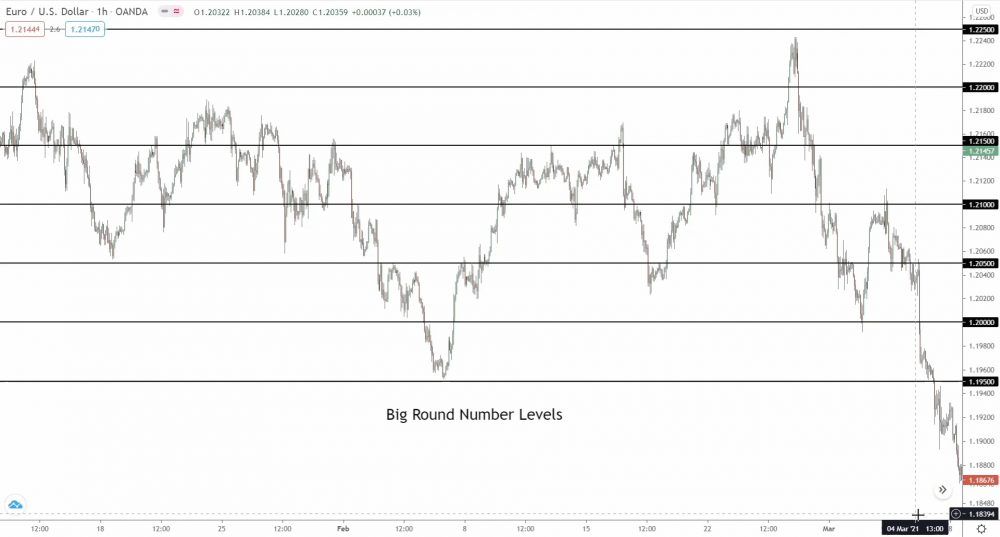
The lines resemble support and resistance levels, except that the levels materialize at big, round-number prices, instead of price levels featuring multiple touches.
Now, did you catch this…?
Most trend-altering reversals kick off with the price hovering around a psychological level, right?
See how often that occurs?
Well, this ain’t coincidence or a stroke of luck – it unfolds for a reason. A reason that’s deeply ingrained in how traders perceive those significant round-number prices and their reactions as the price nears those round figures.
Allow me to elaborate…
Why Psychological Levels Are So Important (And Powerful)
At first glance, psychological levels seem just like any other price, except with a nice neat round number at the end.
That’s about it, right?
But hold on, there’s actually some pretty weird stuff that goes on when it comes to round numbers.
Peep the following image….
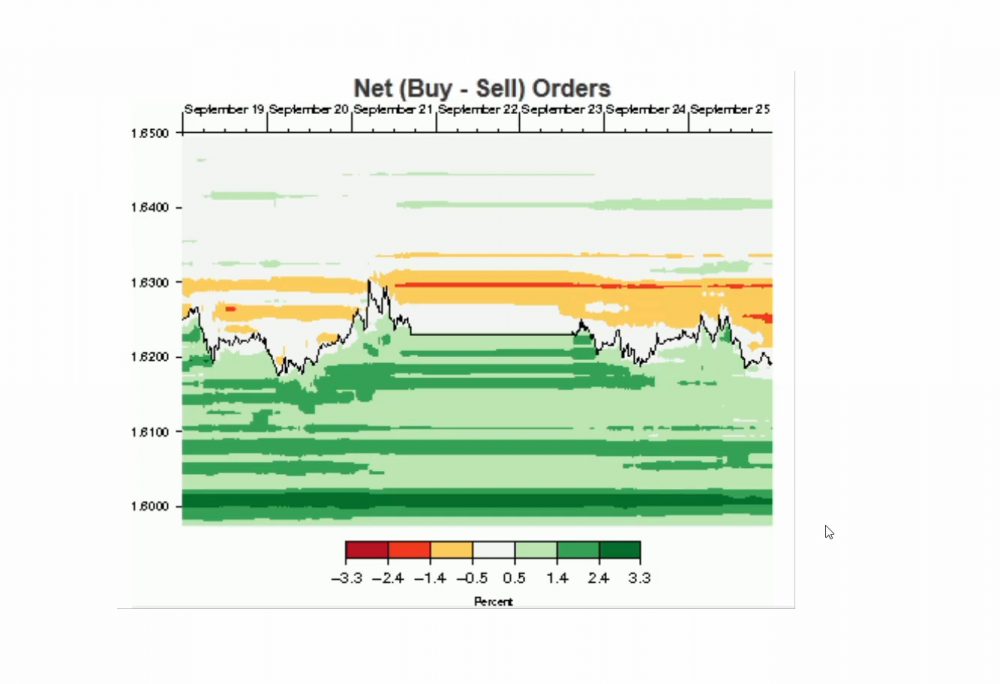
The above image showcases Oanda’s now-defunct order positioning tool.
This heatmap displays a historical breakdown of open buy and sell orders by Oanda traders—including stop loss and take profit orders.
Take a closer look at the heatmap… what do you notice?
What immediately catches your attention?
Examine the prices on the left side…
The highest concentration of orders—represented by dark green and red hues—accumulate around psychological levels. Odd, isn’t it? What compels swarms of traders to place buy and sell orders at or near these round number prices?
The answer: Round number bias.
As humans, our brains crave simplicity.
Our minds instinctively seek simplicity whenever possible to reduce cognitive load and streamline our lives. Evolution has bestowed upon us (or cursed, in some cases) quick, efficient shortcuts in our thought processes.
One such shortcut is round number bias.
Round number bias implies that we assign greater importance to round numbers, particularly whole numbers ending in zeros, over complex, irregular numbers.
For instance:
If I asked you to remember these two numbers…
1.258453, and…
1.250000
Which one would you likely remember?
You’d recall 1.25000!
Why?
It’s a whole number! A number like 1.25000 demands far less effort to remember than a convoluted number like 1.258453. This simplicity prompts our brain to attribute more significance and importance to round numbers than to messy, uneven figures.
The larger the number, the more significance our brain assigns to it.
In trading, this bias – which remains unnoticed by most individuals – prompts traders to place their orders at big round number prices, such as those ending in 500, 000, or 0000.
That’s the reason behind the accumulation of orders at BRNs on the graph – retail traders are drawn to these prices. But why?
- #1 BRNs make the order easy to recall, as demonstrated in numerous studies.
- #2 Traders assume that BRNs hold greater importance due to this inherent bias.
So, that explains the concentration of orders at round number prices. However, what causes the price to often reverse – as we observed earlier – from these psychological levels? Orders alone can’t trigger a price reversal; another force must enter the market and utilize the orders.
The answer… Smart money traders.
These smart money traders are responsible for making the price reverse from psychological levels.
The rationale for this phenomenon lies in their unique approach to navigating the market.
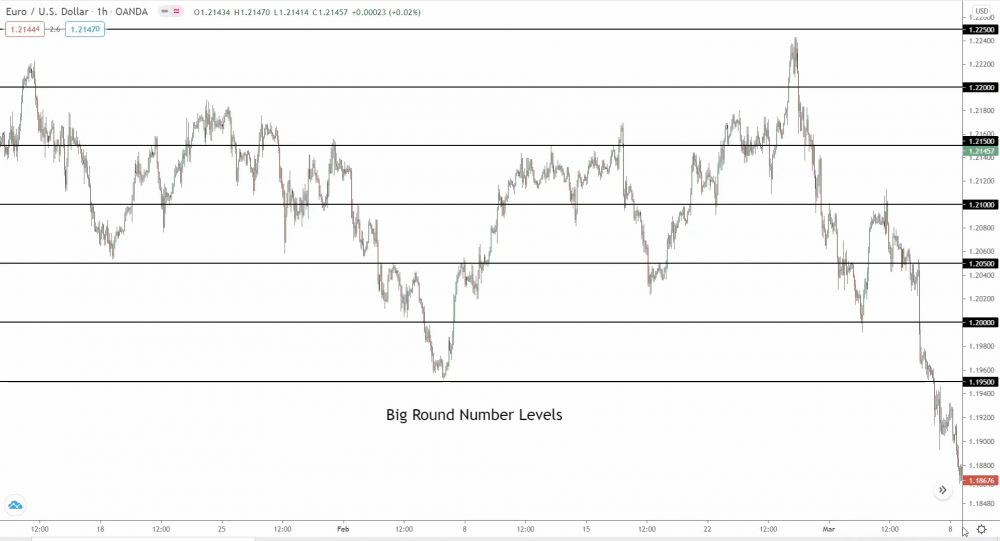
Smart money traders place such huge positions that they just can’t enter all at once.
These positions need a ton of opposing orders, so finding the right amount of buyers or sellers turns into mission impossible.
To make life easier, they push price toward hotspots:
Points where a mountain of buy and sell orders accumulate.
The extra orders help ’em slip their positions right in.
Got it?
Psychological levels create the strongest hotspots, because of the massive number of orders piling up at those Big Round Number (BRN) prices.
Keep this in mind: Orders = people itching to buy or sell.
This rule stays true even when the order isn’t for trading – for example, a stop-loss order means someone wants to buy, even if it’s just for risk management. By steering price into these orders, the Smart Money (SM) can round up a whole bunch of opposing buyers or sellers for their positions.
Here’s how it goes down:
- The SM moves price to the psychological level, setting off the orders.
- The SM jumps in with their positions, using the just-triggered orders.
- The market reverses, making price swing the other way.
And the grand finale?
A massive reversal from a psychological level.
That’s why so many trend-ending reversals kick off at or near psychological levels! It’s the smart money traders using the orders to help enter their gigantic positions.
Take a gander at your charts, and you’ll see it with your own eyes.
Most game-changing, market-shaking reversals start when the price hits or gets close to a psychological level—usually prices ending in 500 or 0000.
3 Clever Ways To Use Psychological Levels In Your Trading
Now lets go through some prime ways to use psychological levels in your trading!
Check this out:
#1: Psychological levels give you rock-solid points of confluence to use with other technical levels. Plus, you can use them to help predict reversals and retracements.
Fun fact: Psychological levels never lose their validity or importance!
#2: Use these levels to watch for reversals when no other recent technical points (like support and resistance levels or supply and demand zones) are around. Super handy during long trending markets when historical price action is too ancient to be valid.
Nifty, right?
#1: How To Use Psychological levels As Confluence
Okay, I’m not head over heels for confluence… it’s a bit too subjective for me! But psychological levels are one of the few I actually use in my trading.
You see, a ton of orders pile up around psychological levels, and the smart money knows they can use those orders to enter more positions. So, when a psychological level lines up with a technical level, the chances of a price reversal skyrocket!
Here’s what the smart money does:
- Push price into the level,
- Use the orders to enter their positions,
- And hopefully cause a significant reversal.
Let’s break it down:
Treat psychological levels as confluence just like any other technical points of interest: Mark your level/zone on the chart, and see if a psychological level is nearby.
Ta-da!
We’ve got confluence!
If a psychological level is close to a supply zone…
You know the zone has a better chance of sparking a reversal. The level shows that a mountain of buy and sell orders are just waiting below. The smart money will probably drive price into these orders to enter their positions, making price reverse.
Here’s a quick example…
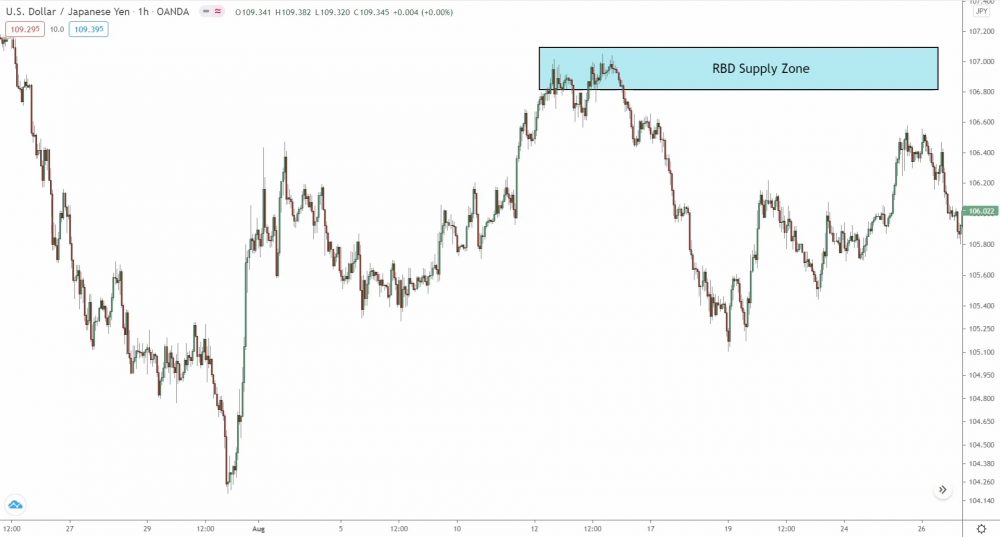
Let’s kick it off by marking your level or zone on the chart—like this supply zone, for example.
Supply and demand zones work wonders with psychological level confluence. The zone highlights a spot where those smart money want to buy or sell. Mix that with orders at the psychological level, and boom! A reversal becomes way more likely.
Other cool technical points that go hand-in-hand with psychological levels are:
Now, let’s move on to the next step…
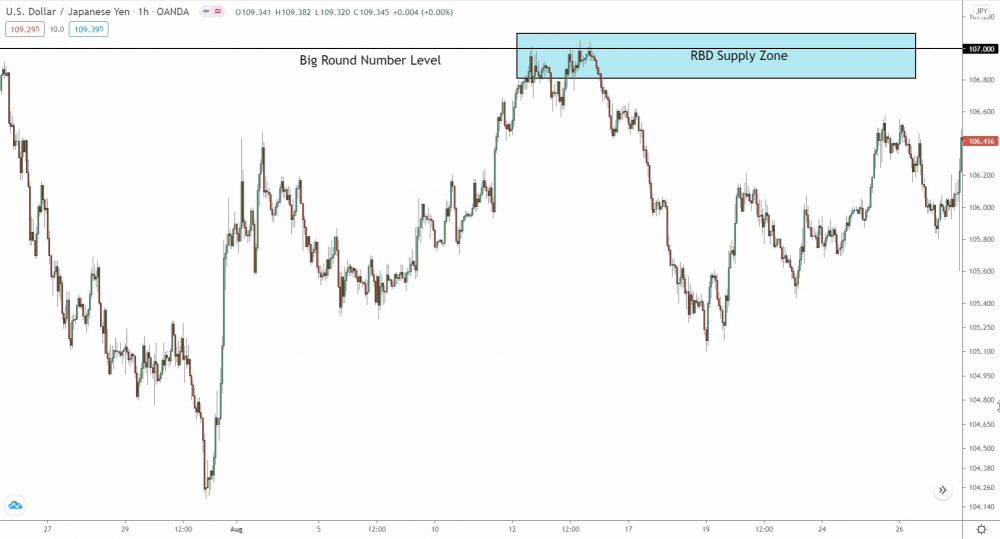
Find any psychological levels in line with or close to the zone. For this one, the 107.000 psychological level cuts right through the heart of the supply zone.
So, you’ve got some sweet confluence…
There are tons of orders hanging around this level.
The smart money traders will probably push the price into these orders to help them get into their positions. As a result, the odds of seeing price reverse to the downside shoot up!
All that’s left is to trade that zone.
Here’s what you gotta do:
- Wait for the price to move into the supply zone,
- Check if a bearish engulf or bearish pin bar shows up,
- Enter a trade and set a stop loss.
Let’s see how it plays out…
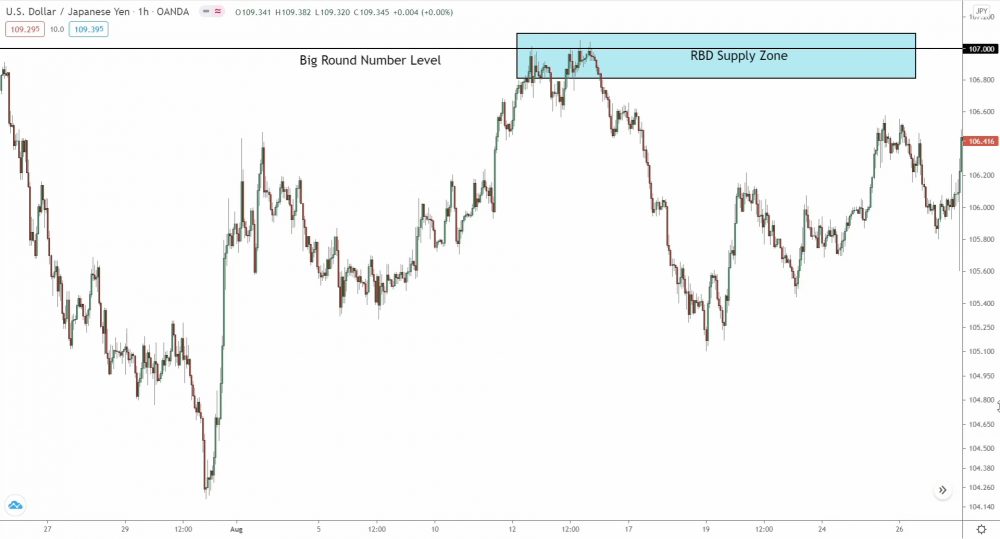
Bingo!
The trade works like a charm!
Price enters the zone, spikes the psychological level, then reverses. The reversal dishes out a neat bearish engulfing pattern, which hands you an awesome short entry.
After the engulf forms, price keeps dropping.
Now, just move your stop and take profits as the price falls.
Easy-peasy!
#2 Use Psychological Levels To Predict Large Reversals
Mark a psychological level on the chart, and suddenly, it all becomes clear:
Most significant, trend-changing reversals kick off when the price reaches or comes within close proximity to a psychological level – usually, a price ending in 500 or 0000.
Like I mentioned earlier, there’s a reason for this: Orders!
Heaps of buy and sell orders pile up around psychological levels, turning them into prime spots for smart money traders to nudge price and hop into their positions.
Here’s the play-by-play:
- The smart money (SM) pushes the price close to the number.
- The buy or sell orders execute.
- The SM enter their positions.
And then, voilà!
Price reverses, all because the smart money traders cleverly use those orders to position themselves just right – since they can’t enter all at once due to a lack of opposing orders.
So, what’s the takeaway?
Psychological levels can be your trusty crystal ball, helping you anticipate and predict significant reversals. Just treat the number like a support/resistance (S/R) level and keep an eye out for price showing signs of a reversal.
For instance:
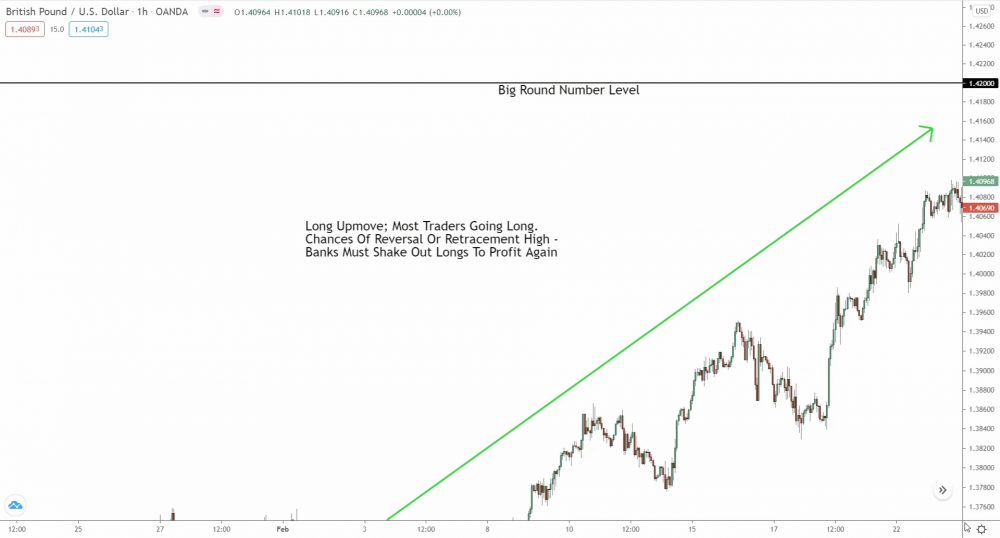
The chart above showcases the 1.42000 psychological level on GBP/USD.
This psychological level suggests there’s a high probability price will reverses at this point due to the accumulation of orders. However, it’s crucial not to assume price will automatically reverse at psychological levels…
Hold your horses!
Wait for confirmation the smart money is utilizing the orders.
Common signs to look out for include:
- Pin bars
- Engulfing patterns
- Large range candlesticks
These patterns confirm smart money selling, making a reversal more probable.
Now, here’s a key point:
Consider psychological levels as zones, rather than just levels.
Orders may cluster around the psychological level, but many exist in the vicinity of the level rather than at the precise number itself.
For instance, if we draw a zone around the number…
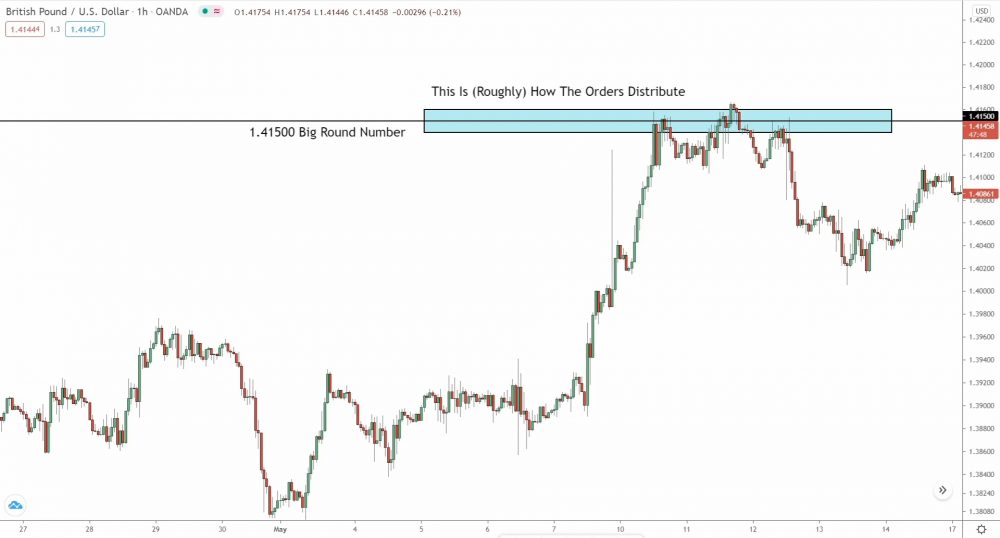
You’ll see a rough illustration of how orders are dispersed around the level.
So, treat psychological levels as zones instead of lines. To draw a psychological level as a zone: identify the number and expand both edges by 10 pips on either side.
In our example, the number is 1.42000.
Your zone should span from 1.41900 to 1.42100, encompassing the entire area where orders are present.
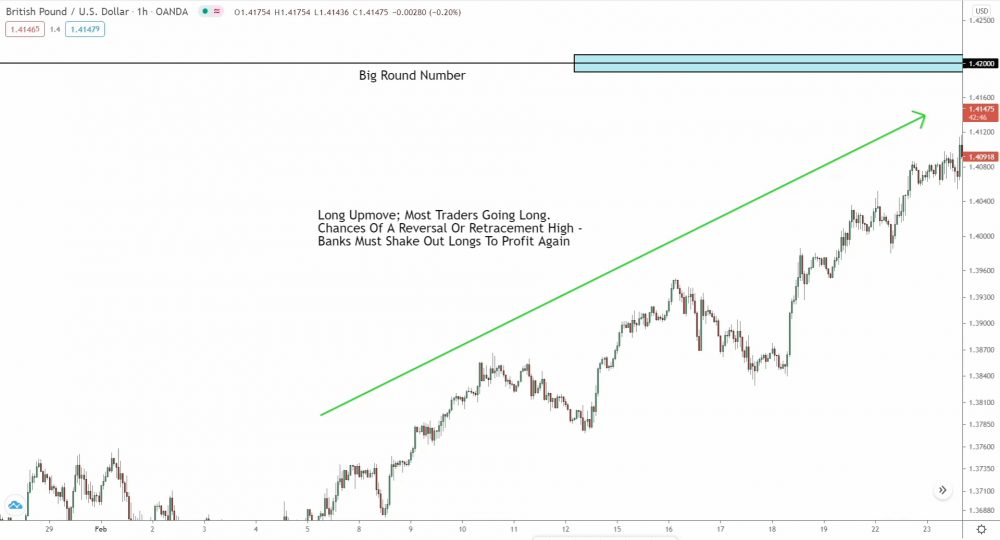
With the supply zone drawn, wait for bearish price action to signal a reversal.
Moving forward…
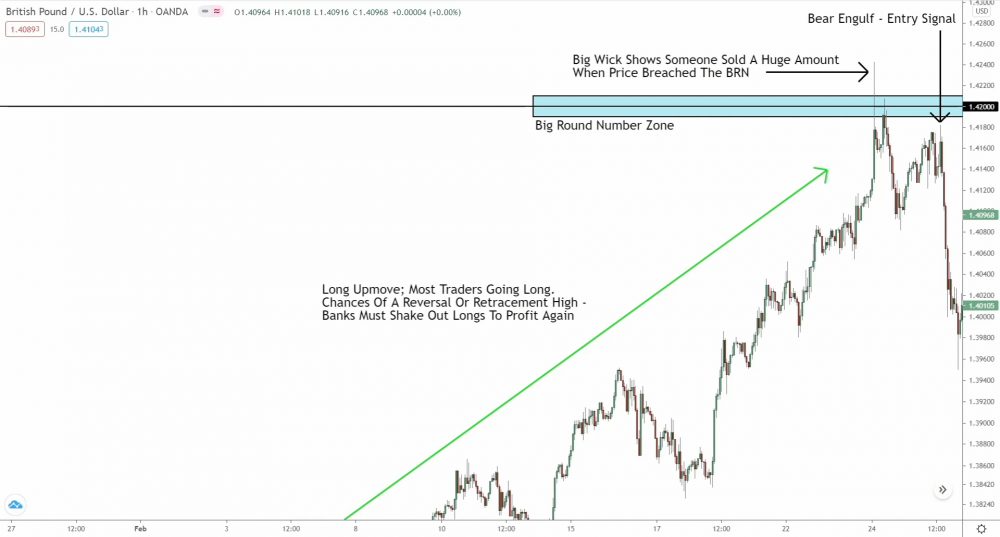
Price soon moves into the zone, and a bearish engulfing pattern forms.
The engulf confirms the smart money used the orders to sell. Why did they sell? Well, for one of three reasons:
- To enter new sell positions for a reversal.
- To take profits off open long trades.
- To close existing long trades.
You can’t pinpoint the exact cause of the engulf, but hey, that’s not really the point. The engulf itself shows the smart money is selling, and that’s a signal you can use to get short into the reversal.
Pretty useful, right?
And, moving forward again….
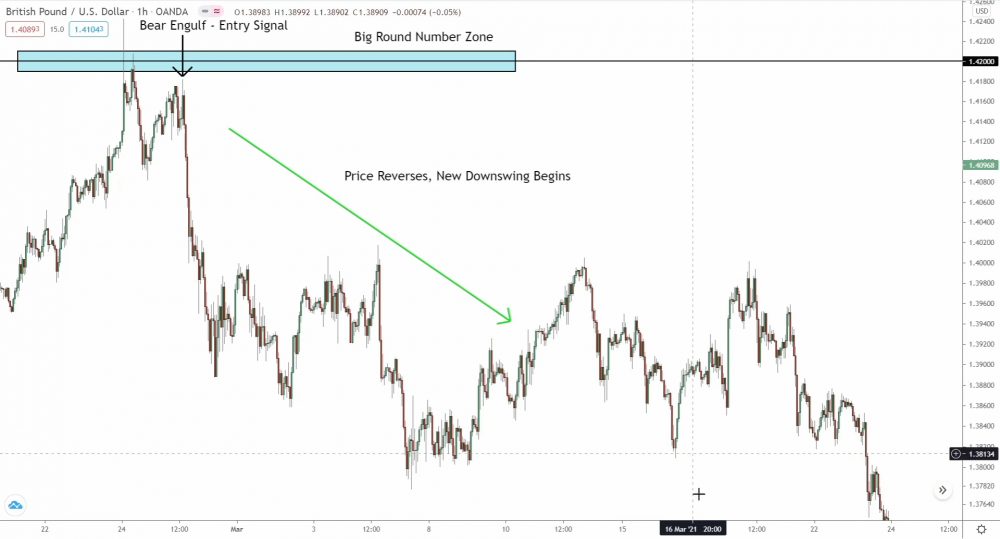
After the bearish engulf, prices does a total 180!
Sweet short trade, right?
You could wait for for a steep drop before jumping in – that’s how I roll.
Sure, the extra price action gives you more confidence, but it’s not always a must-have. Most of the time, the engulfing pattern or pin bar is plenty to show you the smart money are buying or selling, and that’s your cue to get in on the action.
#3 Use Psychological Levels As Reversal Points When No Others Exist
Riding the wave from point 2, here’s another killer way to use psychological levels: as reversal points when there’s nothing else around!
Picture this, for example…
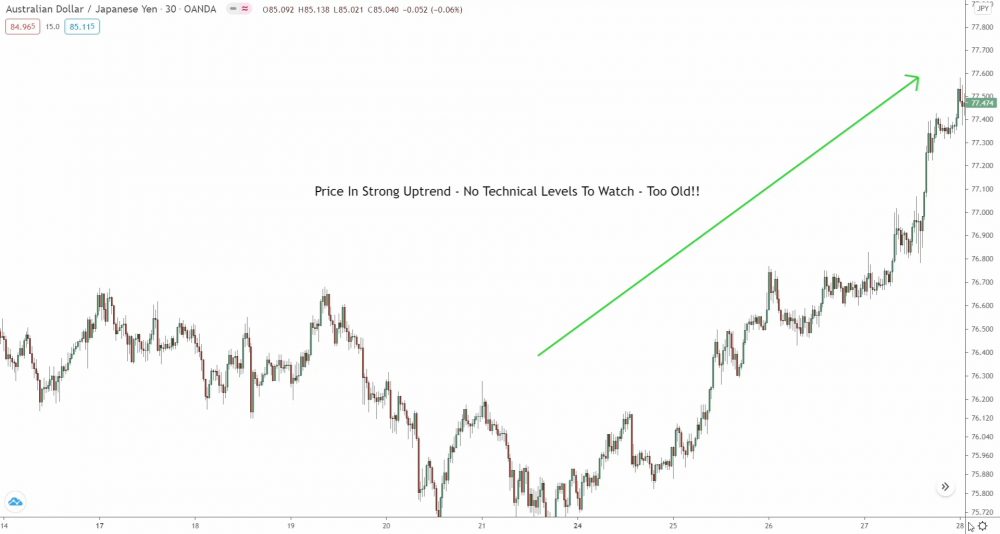
Peering at the chart, you’ll notice price trending higher.
Awesome, right?
Trends = opportunity!
But wait, there’s a catch… With no technical points to monitor for reversals or retracements, things get a bit tricky. Price has rocketed beyond the historical price action. All those standard markers, such as supply and demand zones or S/R levels, are too outdated now.
They’re practically useless!
So, you might think there’s no way to predict where the price could reverse. You’re stuck relying on the current price action, right?
Think again!
Introducing… Psychological levels!
While traditional technical levels lose relevance over time, psychological levels remain rock-solid. Traders consistently place orders at big round number (BRN) levels, no matter how old or where they’re located in the market.
As price nears a BRN, orders start piling up.
When price drifts away, those orders dwindle down again.
So, here’s the deal: You can harness psychological levels to anticipate reversals, retracements, and consolidations when other technical levels are obsolete because the numbers never lose their importance.
Now, let’s circle back to our example…
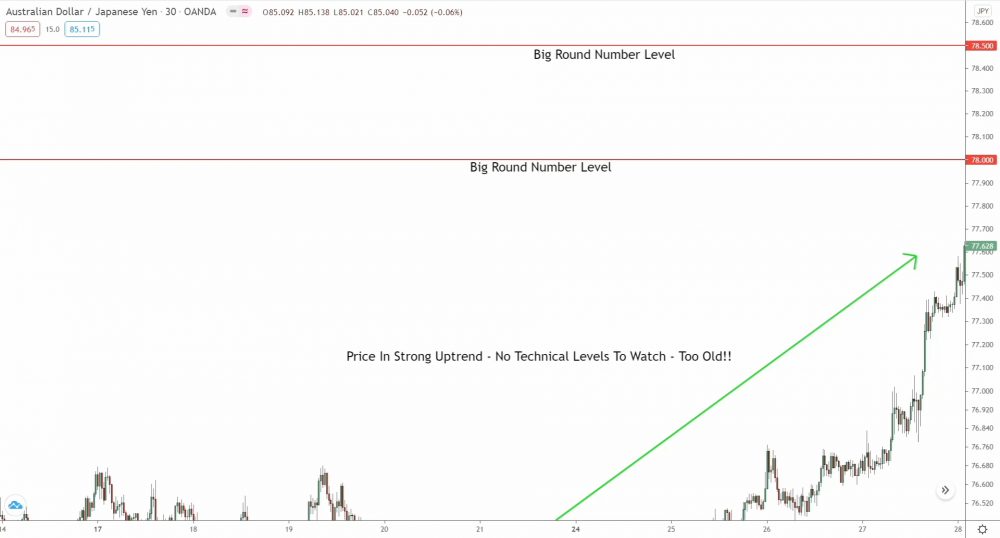
So price is trending higher, and no recent technical points exist.
But hey, no worries!
You can use psychological levels instead – check out those red lines, will ya?
These lines mark the two closest psychological numbers: the 78,000 level and the 78,500 level.
Thousands of orders exist around these prices, making a reversal super likely. Just watch the price action that unfolds when price nears these levels, and you can get a sense of if and when a reversal might kick off.
So, what’s next…
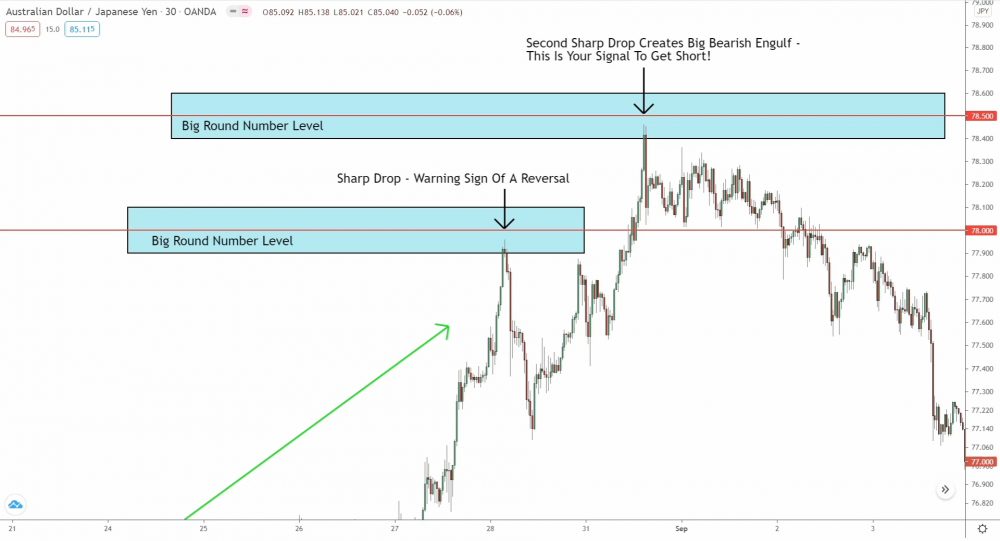
When the price hits that first psychological number – the 78.000 level – a sharp retracement happens. Some traders might see this as a reversal, but without any major bearish entry signals, you just can’t dive into a short trade.
And then, guess what?
Price keeps on climbing higher…
Once it reaches the second psychological number – the 78,500 level – price drops like a rock, forming a large bearish engulfing pattern.
This engulf suggests the smart money might be initiating large sell positions.
Keep in mind: Price can only fall when sell orders surpass buy orders. In a strong uptrend, most traders are buying, leading to an influx of buy orders.
For the price to now drop, a deluge of sell orders must enter.
But who would sell during a strong upswing? Which group of traders?
The smart money, naturally!
Smart money traders sell into the buying frenzy. Why? For one of three reasons: to enter sell trades, take profits from long positions, or close open long trades.
Which one was it?
At this point, nobody knows.
Nonetheless, simply being aware that smart money traders are actively selling at a psychological level equips you with valuable information for your analysis.
So, in this case, the big round numbers offered some clues about where the price could reverse when no other technical levels – like S/R or S/D – were valid anymore.
You didn’t know which number the price would reverse at,
Nor did you understand why the price was reversing,
But that’s beside the point…
The crux of the matter is that you had some inkling of where the price could reverse. And, by observing the price action, you discerned when price could be reversing – information you wouldn’t have without comprehending psychological levels since no other technical levels formed at these prices.
